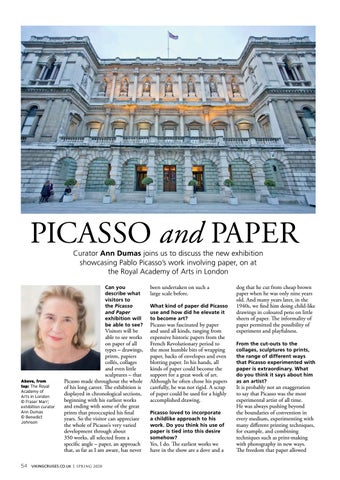PICASSO and PAPER Curator Ann Dumas joins us to discuss the new exhibition showcasing Pablo Picasso’s work involving paper, on at the Royal Academy of Arts in London Can you describe what visitors to the Picasso and Paper exhibition will be able to see?
Above, from top: The Royal Academy of Arts in London © Fraser Marr; exhibition curator Ann Dumas © Benedict Johnson
54
Visitors will be able to see works on paper of all types – drawings, prints, papiers collés, collages and even little sculptures – that Picasso made throughout the whole of his long career. The exhibition is displayed in chronological sections, beginning with his earliest works and ending with some of the great prints that preoccupied his final years. So the visitor can appreciate the whole of Picasso’s very varied development through about 350 works, all selected from a specific angle – paper, an approach that, as far as I am aware, has never
VIKINGCRUISES.CO.UK | SPR ING 2020
been undertaken on such a large scale before. What kind of paper did Picasso use and how did he elevate it to become art?
Picasso was fascinated by paper and used all kinds, ranging from expensive historic papers from the French Revolutionary period to the most humble bits of wrapping paper, backs of envelopes and even blotting paper. In his hands, all kinds of paper could become the support for a great work of art. Although he often chose his papers carefully, he was not rigid. A scrap of paper could be used for a highly accomplished drawing. Picasso loved to incorporate a childlike approach to his work. Do you think his use of paper is tied into this desire somehow?
Yes, I do. The earliest works we have in the show are a dove and a
dog that he cut from cheap brown paper when he was only nine years old. And many years later, in the 1940s, we find him doing child-like drawings in coloured pens on little sheets of paper. The informality of paper permitted the possibility of experiment and playfulness. From the cut-outs to the collages, sculptures to prints, the range of different ways that Picasso experimented with paper is extraordinary. What do you think it says about him as an artist?
It is probably not an exaggeration to say that Picasso was the most experimental artist of all time. He was always pushing beyond the boundaries of convention in every medium, experimenting with many different printing techniques, for example, and combining techniques such as print-making with photography in new ways. The freedom that paper allowed



















